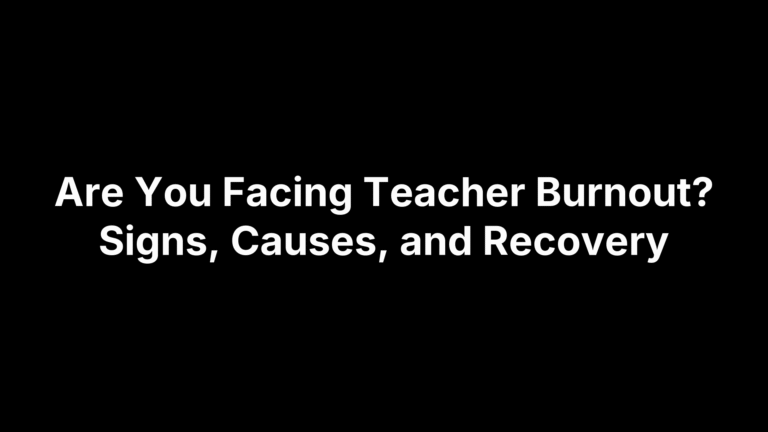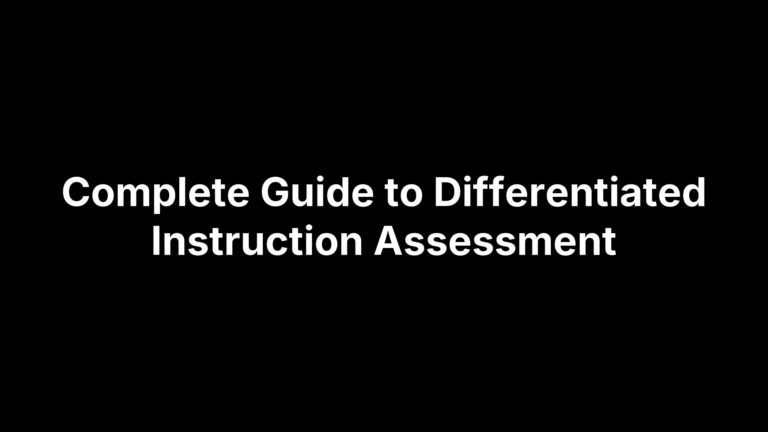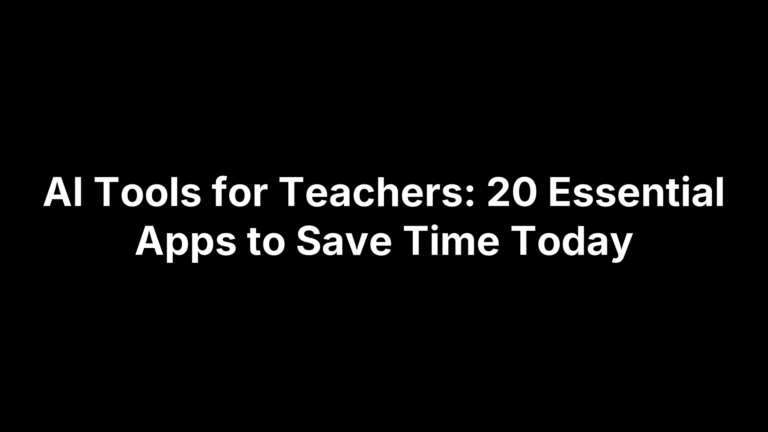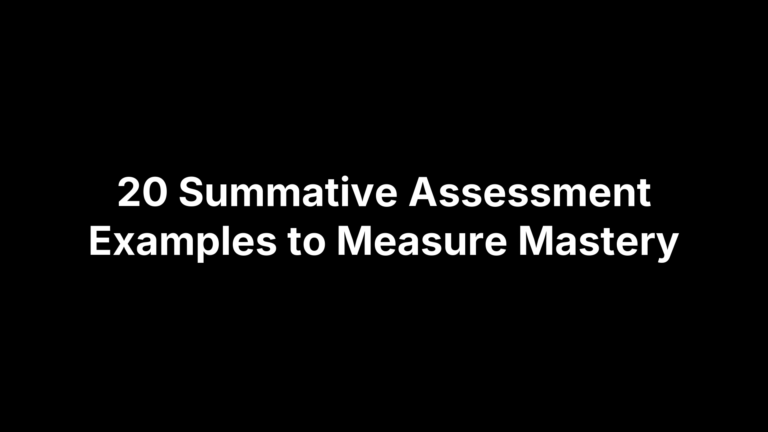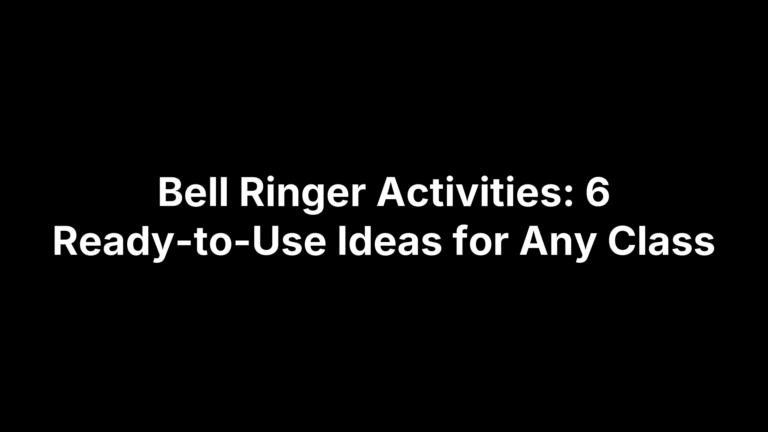Growth Mindset Activities: 25 Engaging Ideas for Classrooms
A student freezes after a wrong answer, whispers “I’m just bad at math,” and mentally checks out. Moments like this are why growth mindset instruction belongs in every lesson plan. When learners see intelligence as elastic—strengthened by effort, strategies, and feedback—errors become footholds instead of cliffs, and perseverance starts to feel natural.
The challenge is turning that research into classroom routines that survive a packed schedule. That’s where this guide comes in. You’re about to gain 25 classroom-tested growth mindset activities, each one packaged with clear objectives, step-by-step directions, differentiation ideas, and reflection prompts. Whether you teach second graders sounding out vowel teams or seniors wrestling with calculus proofs, you’ll find plug-and-play options that fit next period’s agenda and the tools you already use.
Below you’ll find the activities grouped as quick wins, project-based explorations, and ongoing habits—plus printable handouts and digital twists for 1:1 environments. Scan for a five-minute starter or map out a month-long journey; either way, you’ll equip students to trade “I can’t” for “I can’t… yet.” Let’s jump in and watch confidence grow alongside content mastery.
1. Brain Builders Workshop: Exploring Neuroplasticity
Launch the unit with a lab that proves brains aren’t static hardware—they wire, fire, and rewire every time we practice.
Purpose & Skill Focus
- Introduce neuroplasticity and the idea that effort strengthens neural connections.
- Links to life-science standards and frames all growth mindset work.
Materials & Prep
- 2-min neuroplasticity video
- Pipe cleaners/yarn
- Chart paper & markers
- “Brain Facts vs. Myths” handout
How to Run It
- Watch video, note one wow-fact.
- Groups model neurons with pipe cleaners; label synapse.
- Brainstorm “Brain Builders” on chart and practice adding “…yet” to fixed statements.
Reflection & Extension
- Exit ticket: one habit they’ll try this week.
- Extension: create comic strip of neurons firing during practice.
2. The Power of “Yet” Wall
One small word flips defeatist talk. The “Yet” Wall makes that flip visible, encouraging students to practice hopeful language daily.
Purpose & Skill Focus
- Replaces fixed self-talk with possibility
- Meets language-arts standards on precise word choice
Setup & Materials
- Bulletin board or Padlet
- Sticky notes & sentence starters
- Printable Fixed → Growth phrase cards
Procedure
- Quick mini-lesson: turn “I can’t solve this” into “…yet.”
- Students pair-share fixed phrases, write both versions on sticky notes, and post.
- Start each Monday by adding fresh examples and celebrating growth language.
Differentiation & Cross-Curricular Ideas
- Provide sentence frames for ELLs
- World-language groups translate phrases into the target language
3. Famous Failure Gallery Walk
Stories of innovators who bombed before they soared rewire students’ beliefs about talent. A gallery walk lets them mine these biographies for evidence that setbacks fuel, rather than foil, success.
Purpose & Skill Focus
- Spotlight perseverance patterns
- Practice summarizing failure → strategy → achievement sequences
Materials & Prep
- 8 posters of diverse figures + QR bios
- Note-catcher template
Classroom Steps
- Pairs rotate 2 min per poster, logging key takeaway.
- Whole-class fishbowl: What themes link these failures?
Extension
- Create a new poster of a personal hero or interview family about a setback.
4. SMART Goal-Setting Ladder
Goals stick when students can see each micro-step on a visible ladder.
Purpose & Skill Focus
- Turns vague wishes into concrete, measurable action.
- Practices self-regulation per CASEL’s SEL standards.
Resources Needed
- Ladder organizer (paper/digital)
- Sample goals to model
Implementation
- Model converting “do better in math” into SMART steps on the first three rungs.
- Students create ladders, then swap for a 45-second SMART check with a peer.
- Each Friday, color the last completed rung and set the next micro-step.
Differentiation
- Spreadsheet template autofills dates.
- Sentence stems support younger writers.
5. Reflective Learning Journals
A journal transforms day-to-day lessons into an ongoing dialogue about effort, strategy, and improvement.
Purpose & Skill Focus
- Builds metacognition; students compare effort, strategies, and results.
Materials
- Notebook or shared Google Doc with growth-focused prompts
- Color pens or emoji rubric for mood tracking
Routine
- At lesson close, write for five minutes on today’s key mistake using the prompt.
- Weekly, the teacher adds one comment praising a cited strategy.
Assessment & Extension
- Score bi-weekly on reflection depth; offer sketch-note option for artists.
- Pair-share one insight during Friday circle.
6. Gritty Challenge Station Rotation
This rotation turns routine practice into a mini-obstacle course where struggle is expected and strategy talk is mandatory.
Purpose & Skill Focus
- Build persistence through graduated challenges
- Make students name and compare problem-solving strategies
Setup
- Four stations: Easy, Stretch, Struggle, Expert; timer visible
- Self-assessment card for attempts and tactics
Directions
- Start at Easy, record strategy, move on buzzer.
- Rotate through all tables, starring the task that felt “just right.”
- Debrief: chart which strategies traveled best.
Modifications
- Color-code tasks for reading levels; partners allowed until Expert.
- Convert to Google Forms for 1:1 or homework play.
7. Class Mistake Meetings
A brisk, five-minute Mistake Meeting reframes blunders as classwide puzzles, letting students practice diagnosing errors without stigma.
Purpose & Skill Focus
- Normalize errors as learning data
- Build collective problem-solving talk
Materials
- Whiteboard or projector
- Anonymous mistake submission box
Facilitation Steps
- Students drop slips during lesson; teacher selects one common error.
- Display work, hide name, ask: “Where did thinking veer off?”
- Invite volunteers to repair, highlight strategy, applaud bravery.
Reflection
- Exit slip: one mistake I now appreciate
8. Two Stars and a Wish Peer Feedback
Students give balanced feedback without crushing confidence when they use the simple “two stars and a wish” frame.
Purpose & Skill Focus
- Provide optimistic critique; practice evidence-based feedback and revision.
Materials
- Feedback cards or Google Form; model sentence stems.
Implementation
- Teach structure with a sample paragraph; class identifies two strengths and one “next step.”
- Partners trade work, record stars and wish; writer paraphrases feedback to confirm understanding.
Extensions
- Turn wishes into mini-goals and track progress on the next draft.
9. Growth Mindset Quote of the Day
A short daily quotation seeds perseverance thinking and signals that mindset work is ongoing, not one-off. Students learn to mine ideas from small snippets.
Purpose & Skill Focus
- Micro-dose of inspiration
- Practices real-world text connection
Setup
- Slide template or poster space
- Student suggestion jar
Procedure
- Moderator reads quote, states author.
- Class predicts link to today’s work.
- Two volunteers share application ideas.
Differentiation
- Invite illustrations or digital memes for visual thinkers.
10. Stretch Zone Tracker
Finding the sweet spot between boredom and overwhelm is half the battle in learning. A Stretch Zone Tracker turns that invisible feeling into a moveable, shareable visual students can tweak in real time.
Purpose & Skill Focus
- Builds self-awareness around comfort, stretch, and panic zones
- Promotes timely help-seeking and risk-taking
Materials
- Three-zone poster + student name magnets or emojis
- Pocket-size tracker strip for notebooks
Steps
- Mini-lesson: act out Comfort, Stretch, Panic examples.
- Before work, students place marker in their starting zone.
- Mid-task, 10-second pause: slide marker if feelings shift.
- Debrief: popcorn one strategy that kept or returned them to Stretch.
Extension
- Collect tracker strips each Friday; graph class zone trends in math for data talk.
11. Learning Pit Visual Mapping
Most students feel the sting of confusion but can’t see a path forward. The Learning Pit turns that invisible climb into a roadmap they can plan around.
Purpose & Skill Focus
- Anticipate productive struggle; normalize confusion
- Generate strategies for getting out
Resources
- Poster-size pit graphic or slide
- Student mapping worksheet
Implementation
- Explain phases—challenge, dip, climb, aha.
- Students note a tough topic and factors that push them down.
- Pairs list climb-out tactics and post them on the class graphic.
Adaptations
- Use digital mind map with links to tutorials for 1:1 classes
12. Strategy Swap Circle
Students unlock grit faster when their option list is long. Strategy Swap Circle crowdsources practical tactics in minutes, turning individual breakthroughs into classwide know-how.
Purpose & Skill Focus
- Expand strategy toolkits while practicing concise, confident explanation.
Materials
- Strategy cards, talking piece, template or notebook.
Flow
- Form a circle; give everyone one strategy card.
- Speaker holding the talking piece explains how the tactic helped conquer a recent challenge while listeners record it.
- Pass both card and talking piece clockwise; repeat two more rounds.
Assessment
- Exit slip: choose one borrowed strategy to test this week and rate confidence 1–5.
13. Origami Perseverance Challenge
Origami turns the abstract idea of “practice makes perfect” into a crisp, paper-folded reality; every new crease documents growth in real time.
Purpose & Skill Focus
- Concrete proof that practice breeds mastery
- Applies geometry terms (vertex, symmetry, angle bisector)
Materials
- Square paper
- 4-min how-to video of a jumping frog
Sequence
- Watch first fold slowly; note geometry vocab.
- Fold same model three times, timing each try; log errors.
- Graph time vs. accuracy and discuss the resulting learning-curve shape.
Extensions
- Compare improvement graphs to practicing scales in music or layups in basketball.
14. STEM Prototype Iteration Cycle
A rapid build sprint proves the first idea is rarely the best—iteration, not perfection, earns the grade.
Purpose & Skill Focus
- Highlights iterative design and data-driven problem solving.
Equipment
- straws, tape, paper clips, cardstock, stopwatch
Steps
- Present brief—build a paper tower that holds
100 g. - Teams sketch and build Version 1 in 8 min; test, note height and collapse point.
- Revise and retest twice; final share-out celebrates greatest improvement, not tallest structure.
Cross-Curricular Tie-Ins
Graph load vs. iterations in math; compare to inventors’ redesigns in history.
15. Growth Mindset Role-Play Scenarios
Stepping into character makes mindsets audible; students hear the power of words and practice swapping fixed scripts for growth responses.
Purpose & Skill Focus
- Practice resilience language in everyday conflicts
- Build empathy and active listening
Materials
- Scenario cards, timer, optional phone camera for playback
Facilitation
- Groups pick a card; rehearse 2-minute scene showing fixed mindset first.
- Rerun scene substituting growth-oriented dialogue; audience names verbal cues.
- Whole class debriefs: which phrases shifted emotions or outcomes?
Adaptations
- Record performances for self-analysis and rubrics on strategy use
16. Myelin Meditation: Mindfulness for Focus
A short, science-infused mindfulness break shows students that every intentional repetition wraps their “brain wires” in myelin, boosting speed and accuracy.
Purpose & Skill Focus
- Connects mindfulness to neuroplasticity vocabulary
- Improves sustained attention before challenging work
Setup
- 3-minute guided audio (teacher-recorded or free app)
- Slide of an axon gaining myelin layers
Routine
- Dim lights; students sit tall, eyes closed.
- Guide breathing: inhale “new layer,” exhale “distractions.”
- After bell, set a personal focus intention for the next task.
Evidence & Reflection
- Quick hand-raise poll: focus level 1–5 pre/post.
- Pair-share one strategy to keep myelin building during independent work.
17. Growth Mindset Bingo
Growth Mindset Bingo turns everyday perseverance moves into a low-stakes game students actually want to keep playing.
Purpose & Skill Focus
- Gamifies repeated growth behaviors while strengthening self-monitoring and motivation
Materials
- Bingo card with actions (ask feedback, revise draft, use “yet”)
- Stickers or digital checkmarks
Play
- Hand out cards; review squares.
- Students mark when action done—peer initials confirm.
- First bingo shares quick win; aim for blackout.
Differentiation
- Level cards by age or let students swap one square for a personal stretch goal
18. Coding Debugging Marathon
Purpose & Skill Focus
- Demonstrates persistence and iterative problem-solving in computer science
- Reinforces debugging of syntax and logic errors while normalizing trial-and-error
Requirements
- Laptops with Scratch or Python IDE
- Pre-written buggy programs of rising complexity
- Attempt-tracking log sheet
Process
- Pair students; assign Level 1 bug.
- Each time the code runs, partners record the error message and strategy tried.
- After a successful fix, advance to the next level and log total attempts.
- End with a stand-up share: biggest “aha” moment and takeaway strategy.
Adaptations
- Use unplugged paper code strips for tech-limited classes.
- Gifted extension: write an original program, then swap with another team to debug.
19. Art of Revision Portfolio
Students often view drafts as disposable; a revision portfolio reframes them as tangible evidence of learning growth over time.
Purpose & Skill Focus
Showcases iterative improvement, builds writing stamina, strengthens metacognition, and normalizes feedback-driven changes across genres too.
Materials
- Revision checklists
- Colored pens/highlighters
- Folder or digital portfolio tool (Google Sites or Slides)
Procedure
Students archive each draft, mark a version number, highlight revisions by category, and attach a brief sticky-note explaining how the edit improves meaning.
Assessment
Grade portfolio on revision openness, reflection quality, and evidence of risk-taking rather than polish.
20. Thinking Aloud Problem-Solving Pairs
A quick partner routine that turns silent problem-solving into shareable talk students can borrow.
Purpose & Skill Focus
- Models metacognition and precise academic language during complex tasks.
Setup
- One multi-step problem; roles: Thinker (talks) and Listener (jots strategies).
Steps
- Thinker narrates every move; Listener captures strategy and questions.
- After two minutes, Listener paraphrases notes, then partners swap with new problem.
- Teams share top strategies; class builds anchor chart for future reference.
Extensions
- Record sessions for a student-made strategy podcast or reflection portfolio.
21. Video Reflection With Self-Assessment Rubric
A one-minute selfie video turns reflection into a low-prep, high-engagement task and provides you with quick, visual evidence of growth.
Purpose & Skill Focus
- Builds metacognition and speaking clarity
- Practices rubric-based self-evaluation
- Normalizes discussing effort, strategies, and next steps
Materials
- Devices with cameras or Flip (free)
- 3-point rubric: effort | strategy use | improvement
Implementation
- Model a 60-second recap: “Here’s what I tried… it worked because… next I will….”
- Students record, then immediately score themselves with the rubric.
- Pair-share videos; partners suggest one strategy to try before the next recording.
Differentiation
- Offer audio-only or written option for camera-shy learners
- Allow ELLs to subtitle in their first language, then add English captions
22. Book Club: Growth Mindset Literature Circles
Stories stick. A well-chosen novel or picture book turns abstract mindset talk into relatable moments of struggle, strategy, and triumph that students can dissect together.
Purpose & Skill Focus
- Deepen mindset understanding through character analysis
- Strengthen discussion, inference, and citation skills
Book & Prep
- Elementary: The Most Magnificent Thing
- Middle: Fish in a Tree
- High School: Selected chapters of Mindset
- Provide question stems and printable “Mindset Evidence” bookmarks
Circle Roles & Meetings
- Roles: Connector, Questioner, Vocabulary Finder, Illustrator
- Weekly 20-minute meetings; each member shares evidence of fixed vs. growth thinking, then the Connector links it to classroom challenges
Culminating Task
Groups create a poster or slide deck titled “How the protagonist embodies growth mindset,” citing three textual moments and one personal application tip.
23. Classroom Affirmation Station
A dedicated corner for uplifting words can calm jitters in seconds. The Affirmation Station invites students to pause, look themselves in the eye (literally or figuratively), and replace “I’m going to bomb” with “I’m prepared and improving.”
Purpose & Skill Focus
- Strengthens positive self-talk and collective encouragement
- Reduces assessment anxiety; builds classroom community
Materials
- Full-length mirror or poster sheet
- Dry-erase markers or sticky notes
- Deck of pre-printed affirmation cards
Deployment
- Before quizzes or presentations, students choose or write an affirmation, say it aloud, and sign their initials.
- Classmates can add peer “shout-outs” on a side board.
- Refresh cards weekly; highlight student-created favorites.
Evidence & Reflection
- Quick digital poll rates anxiety 1–5 before and after a two-week trial; discuss shifts and plan tweaks.
24. 30-Day Personal Challenge Boards
A month-long public commitment turns self-improvement into a visible, trackable game that rewards tiny wins daily.
Purpose & Skill Focus
Builds long-term perseverance, intrinsic motivation, and habit formation while practicing goal-tracking math skills.
Materials
Calendar grids or Google Sheets, sticker stars or emoji icons, optional habit-tracking app.
Steps
- Students choose a skill—push-ups, pages read, new vocab—then write a specific daily target.
- Post goals on a shared board; add a sticker each successful day.
- Celebrate streak milestones with peer high-fives or shout-outs.
Reflection
On day 30, graph progress, note setbacks overcome, and write a paragraph connecting persistence strategies to future challenges.
25. Gratitude & Growth Journaling
Listing gratitude beside growth goals helps students celebrate progress while still chasing improvement.
Purpose & Skill Focus
- Connects gratitude to resilience and optimistic risk-taking
- Builds reflective writing fluency
Supplies
- Two-column journal page or digital template
Routine
- Weekly, list three gratitudes and one improvement target.
- Optional partner share to boost community and accountability.
Research Tie-In
Gratitude releases dopamine, priming the brain for new synapses and sustained effort.
Keep the Momentum Going
Rethinking talent doesn’t happen in a single pep talk—it grows by looping through language, strategy, reflection, and perseverance every day. The 25 growth mindset activities above give you a ready-made cycle:
- language builders like the “Yet” Wall and Affirmation Station shift self-talk
- strategy sharers—from Strategy Swap Circles to Think-Aloud Pairs—expand each learner’s toolkit
- reflection routines such as video check-ins and dual-column journals turn experience into insight
- perseverance workouts, whether an Origami Challenge or 30-Day Board, let students feel progress in their muscles and minds.
Mix and match a five-minute quick win with a week-long project, sprinkle in daily quotes, and you’ll weave growth mindset fibers through every unit without rewriting your curriculum. Ready for fresh printables, digital templates, and AI helpers that cut prep time in half? Browse the free resources and classroom tools waiting on The Cautiously Optimistic Teacher.

